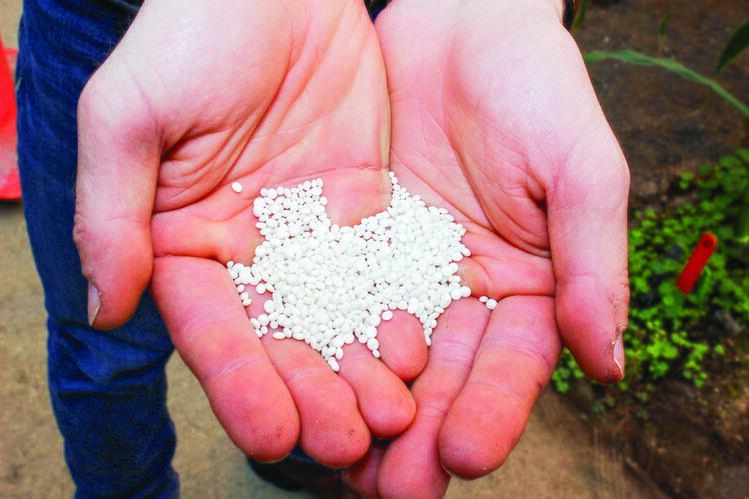Recycled phosphorus fertilizer reduces nutrient leaching, maintains yield

A promising new form of ammonium phosphate fertilizer has been field-tested by University of Illinois Urbana-Champaign researchers. The fertilizer, struvite, offers a triple win for sustainability and crop production, as it recycles nutrients from wastewater streams, reduces leaching of phosphorus and nitrogen in agricultural soils, and maintains or improves soybean yield compared to conventional phosphorus fertilizers.
“There have been some lab and greenhouse projects showing the potential of struvite, but this is the first field-scale assessment of nutrient loss and yield benefits together,” said principal investigator Andrew Margenot, associate professor and faculty Extension specialist in the Department of Crop Sciences, part of the College of Agricultural, Consumer and Environmental Sciences (ACES) at U. of I. “We found that struvite can be a full substitute for monoammonium phosphate (MAP) or diammonium phosphate (DAP) for soybeans yield-wise, and it reduces nonpoint source nutrient losses relative to conventional fertilizer options.”
His team’s results are published in the Journal of Environmental Quality.
Applying MAP or DAP in the fall as a source of phosphorus for crops is common practice for corn and soybean production in much of the Midwest. But because the phosphorus in MAP and DAP is highly water soluble, much of the nutrient is lost during the ensuing winter and early spring months. Not only can this contribute to downstream nutrient pollution, it also means there may be less phosphorus available in the soil by the time crops are planted in spring.
Importantly, MAP and DAP also contain soluble forms of nitrogen, an overlooked fact that Margenot says is contributing to the problem of nitrate loss across the Midwest.
“There is a major blind spot in the nitrogen cycle,” Margenot said. “In the U.S. and the Midwest specifically, the overwhelming majority of our phosphorus fertilizers are ammoniated. When farmers buy a phosphorus source to apply in the fall, their options are generally limited to MAP or DAP, so they can't avoid co-applying nitrogen.”
He did the math in a companion paper and found DAP applied at the typical rate (200 pounds per acre) adds 36 pounds of nitrogen per acre that most farmers — and land grant recommendations — don’t account for. Adding it up across Illinois, Margenot estimated that 198 million pounds of nitrogen are added every fall in the form of MAP or DAP.
“That number is 11% more than our statewide nitrate loss reduction target of 178 million pounds,” he said. “Managing this overlooked fall-applied nitrogen is low-hanging fruit that could make a large dent in nitrate losses in Illinois and other Mississippi River Basin states, and we could do it without changing phosphorus application rates.”
Struvite also contains nitrogen, but struvite is less water soluble than MAP. That explains why Margenot’s team found phosphorus and nitrogen leaching were significantly lower under struvite than MAP, comparable to natural leaching measured in unfertilized soils.
But if the nutrients are less soluble, does that mean plants have a harder time accessing them? Not according to the Journal of Environmental Quality study. Soybean yields weren’t significantly different under either fertilizer. And in the study’s southern Illinois site, struvite — but not MAP — actually increased soybean yield compared to no-fertilizer control plots. Margenot thinks the yield bump could have resulted from the magnesium in struvite.
Struvite (magnesium ammonium phosphate, a 5-28-0 [10 Mg] source) forms when magnesium is added to wastewater, where it reacts with phosphorus and nitrogen and pulls those nutrients out of the waste stream. Chicago and St. Louis have leased portions of their wastewater streams to a company to manufacture the recycled fertilizer, but Margenot says the struvite manufacturing industry is currently too small to satisfy the phosphorus needs of the entire Corn Belt.
“Struvite isn’t scalable right now, but we’re proving the efficacy of a solution that will be on the shelf one day. Our results point to the benefits of scaling up struvite production and use on the farm,” he said.
Although struvite decreased nutrient losses relative to MAP, Margenot notes that nutrient loss happens even without added fertilizer, and recommends cover crops to mitigate these “background” losses that occur regardless of fertilization.
“When we added no fertilizer, be it MAP or struvite, we still saw substantial losses, especially in the higher organic matter Mollisols [black prairie soils] of our Central Illinois site,” he said. “Our soils are so rich; they hold a lot of organic nitrogen and phosphorus. If it's warm enough, these nutrients will mineralize and become nitrate and phosphate. If there's no crop there to grab it, like a cover crop or wheat, then those nutrients will be leached.”
The study, “Field-scale evaluation of struvite phosphorus and nitrogen leaching relative to monoammonium phosphate,” is published in the Journal of Environmental Quality [DOI:10.1002/jeq2.20522]. Authors include Patricia Leon, Yuhei Nakayama, and Andrew Margenot.
Margenot’s companion study, “The fate of nitrogen of ammonium phosphate fertilizers: A blind spot,” is published in Agricultural and Environmental Letters [DOI:10.1002/ael2.20116]. His co-author is Jeonggu Lee.
Both studies were funded in part by the Illinois Nutrient Research and Education Council. Additional funding for the research came from the Illinois Soybean Association and the National Science Foundation.